

Larry Gelberg interview
By Scott Stilphen
(2001)
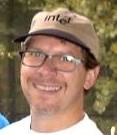
The designer of Atari VCS/2600 Frogger II and the unreleased Ewok Adventure talks about his experiences at Parker Brothers.
Q: What inspired you to get into game programming?
Larry Gelberg: I was always interested in graphics - mostly 3D graphics and animation, but when the opportunity arose to work on games, that sounded like fun, too. Actually, I almost enjoy programming games more than playing them. Programming (especially the old systems) is puzzle-solving: how can I compress the graphics bitmaps more efficiently? Can I use bits of code as a sound
effect? The job nicely combined the best of these interesting technical challenges with creative ones. For instance, we were constantly worrying about introducing "Artificial Stupidity" into the games so that the slow, clumsy humans felt like they had a chance. The goal was to create a game that was challenging, but not frustrating, and one where the challenges increased at higher play levels instead of just getting more stuff thrown at you faster.
The games being written today are what we hoped we could build – real interactive stories - but we were limited by memory and processing power.
Q: When did you work for Parker Brothers? What was it like working for them?
Larry Gelberg: Unfortunately, I joined PB right at the peak of 2600 popularity (October 1982) – after Frogger became a smash hit for them and while Empire Strikes Back and G.I. Joe were being released. I say unfortunately, because even as I was starting up, the market was cooling down, so I was only there for about 2 years (leaving in May of 1984). After the release of Frogger II: Threee Deep!, they laid off everyone and effectively shut down all in-house video game development. At the peak, we had a staff of 75 people involved with video games: programmers, system support, designers, etc.
This was one of the best jobs of my life - we knew we had a great thing going and milked it for all we could. For instance, there was a game room with arcade versions of Q*bert, Amidar, Star Wars, etc. that we could use "when we needed to reference the original game". It was an exciting blend of the creative and the technical that's hard to match in other jobs.
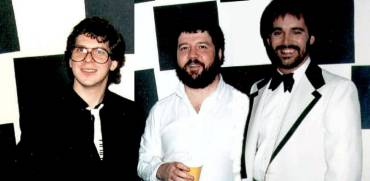
Larry Gelberg, Joe Emerson, and Ray Miller at a “Black & White” party, Dec. 1984
Q: Any memorable stories or anecdotes from your days at PB?
Larry Gelberg: Mark Lesser and I got into a major spat one day when he cut the leg off my stuffed Kermit doll. I accused him of being hypocritical to his peace-loving hippy philosophy. He offered to kick the snot out of me in the parking lot. That was a typical day at work.
Frogger was so successful for PB that they thought it was easy and that they'd be able to reproduce that success game after game, so they really cranked up the machine. One policy that they had that hindered us developers was that they wouldn't even consider an original game idea – all released products had to be tied into existing licensing lines, such as G.I. Joe and Star Wars.
This was part of a long-running dispute between the cocky engineers (like me) who thought we were “Video Game Studs”, and the “Marketing Weasels” who really controlled the company. Since they controlled the products, the money, and the release machine, the MWs won, of course (which was one reason that Ewok Adventure was never released.). This tussle over creative control resulted in the original “Gang of Five” programmers, who did Frogger, Empire Strikes Back, etc. to flee en masse to Activision shortly after I joined. You've got to remember that at that time, Activision programmers were treated like Gods: photos on the boxes, groupies at conferences, and the all-important ROYALTIES! We were treated like employees.
Towards the end (as part of general cost cutting, rather than developing games internally), they tended to look more to port existing, "proven" games that they wouldn't have to market as aggressively. That's how we picked up Tutankham, Popeye, Q*bert, and so on. Also, that way, they could hire contractors/”porters” who were cheaper and less cantankerous (read, "ego-less") than us game developers. We looked upon this
evolution of business thinking with a hefty degree of concern, as it directly affected our potential livelihood and autonomy. Which is ironic of course, since we ended up losing both in pretty short order!
Q: Who were the “Gang of Five” programmers?
Larry Gelberg: Rex Bradford, Charlie Heath, Mike Brody, Jim McGuiness, and Dave Lamkins. Dave was like Jim McGuiness, in that he wasn't so much a programmer as he was a facilitator. He helped with the reverse-engineering of the 2600, wrote some basic modules for doing things like displaying 3 sprites on a line - that sort of thing. He was also the project manager ("Den Mother") for the group.
As it turned out, the GoF never had any of their games released by Activision and in hindsight, it just seems as though Activision bought the programmers to try to hamper PB's competitive edge. Since the market tanked in 1983-84, it didn't really matter, but they were emotional times for us.
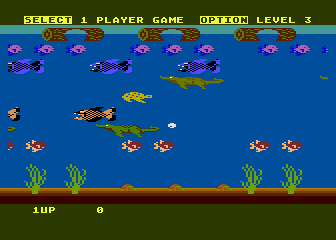 Q: You mentioned that Atari 400/800/5200 Frogger II was the only game you had published. Were there any games that you started, but didn’t finish or get
released (besides Ewok)?
Q: You mentioned that Atari 400/800/5200 Frogger II was the only game you had published. Were there any games that you started, but didn’t finish or get
released (besides Ewok)?
Larry Gelberg: By the time we got around to designing Frogger II, we had changed our modus operandi a bit - since PB wanted (needed) to release a single product across many platforms at the same time, we formed a team of 5 programmers to do group design but individual system programming. We also had access to a graphic artist for artwork. John Emerson was our group leader and composed all the music. I was assigned the Atari 400/800/5200 systems; others had the VCS, Nintendo, and Colecovision systems.
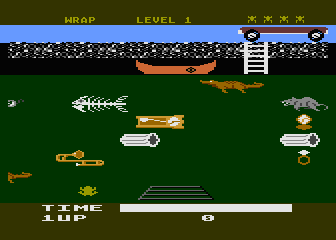
I did some early concept work for the game, including a scene in a sewer where Frogger was dodging junk like chairs and trombones, and, of course, the ubiquitous alligators. I did all the artwork myself. The sewer scene was really just me learning the 5200 using the existing Frogger 5200 version and replacing the graphics. I don't think anyone ever intended that it really make the final cut. Not "family friendly" enough for PB's marketing staff, I'm sure!
Q: How did Ewok Adventure come about?
Larry Gelberg: This was a great opportunity - PB had negotiated with Lucasfilm for rights to build video games based on the upcoming Return of the Jedi film. So Ray “Raymo” Miller, Michelle (don’t recall last name) from Marketing, and I flew out to San Rafael, signed all kinds of non-disclosures, and got to read the script while the film was in production. - well, a 'safe'
version of the script - one without the Luke/Leia sibling connection (but we deduced that over Mai-Tais that night). We got to see some concept artwork and production stills. We then went back and came up with 3-4 game concepts. I kind of latched onto the Ewok hang-gliding thing since I had been hang-gliding once or twice and thought it was really cool. As we all know now, there is only about 2-3 seconds of Ewok hang gliding footage in the movie, but it seemed like a good
idea at the time. Raymo came up with the Breakout-style Death Star Battle game.
One of the restrictions that Lucasfilm put on us was that we weren't allowed to kill Ewoks; that's why when they get shot out of the sky, they shake themselves off and go find another hang glider. Pity. I would really have liked to kill Ewoks.
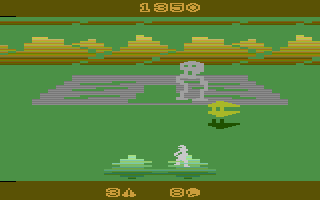
Q: Why was it never released?
Larry Gelberg: Two reasons: financial business considerations and hubris on my part. Things were starting to get tight at PB; everyone was counting on all the video games being as successful as Frogger and that just wasn't happening. The way PB marketed their games was pretty expensive: ad campaigns, packaging, etc. For instance, the cover art for Ewok Adventure was painted by Tim
Hildebrandt (of Fantasy Art fame). Things had cooled down enough in the market, and it cost so much to release a game that they didn't want to diffuse the Star Wars Jedi market too badly. They decided to put all their muscle behind a single game. So it came down to a choice between Death Star Battle (Ray's game) and Ewok Adventure, and the chief Marketing Weasel (the VP, Rich Stearns, who later left PB to join Franklin Mint - purveyor of fine gift items) couldn't get
the hang of the hang-glider controls, so Ewok Adventure became a relic.
That's kind of where my hubris kicked in - I had this artistic vision of the purity of the hang-glider controls - forward dives and speeds you up, back climbs and slows you down, and catching thermals every now and then maintained your altitude. The MWs either didn't get it or just didn't like it. They tried time and time again to get me to put in a mode where you just go in the direction where you point the joystick. But I was young and arrogant and refused, and they
ultimately killed the game. Sorry, everyone.
I'm thrilled that it's been rediscovered and that people finally have a chance to play it and seem to like it. Vindication of the vision 20 years after the fact!
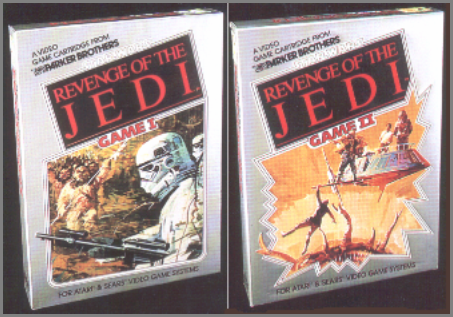
Q: Can you tell me anything about the Game I and Game II prototype boxes?
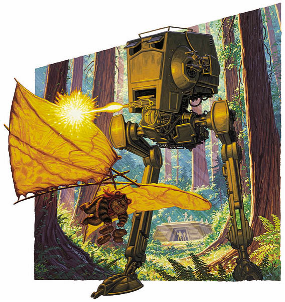
Larry Gelberg: Yeah, I remember seeing those images - they were just placeholders for trade shows and catalogs generated by PB's internal art department. Game II became Death Star Battle. I have no idea about the artwork used. Generally PB went out-of-house for much of the cover art. I used to have a copy of the Hildebrandt cover - it was pretty neat with an AT-ST shooting down a hang glider carrying a terrified-looking Ewok. I had a whole package of Ewok-related stuff - the cover art, a full printout of the source code, and another NTSC prototype that I gave away to a friend's brother about 15 years ago. He's tried to locate it, but thinks it might be in a moving box in a storage center somewhere in Connecticut. It might be worth trying to dig up!
Q: Did any other programmers help you with the games, as far as sound and/or graphics?
Larry Gelberg: I did most of the artwork myself - the 2600 was so restrictive with its graphics that we couldn't really benefit from the help of a graphics artist. One such artist, Gary Goltz, kept making suggestions (like trying to change the color of a sprite within a line, as opposed to across them), and I kept saying, "It can't do that.". The thermal updrafts that you can fly over that boost your altitude were modeled on the Parker Brothers logo swirl.
Q: Are there any Easter eggs in Frogger II?
Larry Gelberg: I don't think there are any Easter Eggs in the other versions of Frogger II versions (we were too busy meeting the deadline!) but in mine I managed to hide my initials "in plain sight" in the clouds in Frog Heaven. If you look at the shading in the clouds, you can see an 'L' to the left of the Frog Berth and a 'G' to the right. Not much of a legacy but there you go.
Q: Back in 1997 you wrote in to the 2600 Connection newsletter to confirm you were the programmer of Ewok - by describing how to find your initials in the game. I noticed with the PAL version the initials display as “TG” (and on the bottom of the screen, instead of the top). Do you know why this is? Was someone else responsible for doing the PAL conversion?
Larry Gelberg: I think that has to do with the vertical scan rate of the PAL version. On NTSC, I think you get a couple more scan lines at the bottom of the screen and you can see the bottom of the 'L'. The 'T' that you see is the serif on top of the 'L'. Maybe you can scroll down to see the rest?
Actually, the PAL versions were all pretty much afterthoughts - our only real PAL considerations and Q/A were to verify that it worked and that the colors didn't look too crappy. One thing to remember is that we were actively discouraged from putting in Easter Eggs. Not only was it against the general principle of the game being "company property", but it also took up valuable ROM space, which could be used for legitimate things like graphics or sounds.
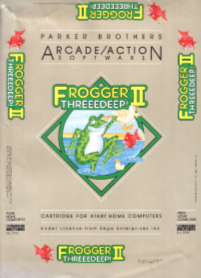
Q: With Frogger II and Ewok Adventure, were there any features you would have liked to added, or any known bugs or glitches that gave you trouble (or never got resolved)?
Larry Gelberg: With Ewok Adventure, I always wish that we had enough room for music, but that was a fairly graphics intensive game, so we didn't have enough memory (even with our whopping 8K!) for tunes. Also, a two-player mode would have been fun.
I'm pretty pleased with Frogger II. I think it's fairly complete, as it stands - nice, compact, and consistent. Remember that for compatibility's sake we were limited to the lowest-level system - the VCS. We could have built 10 additional worlds for the 5200, but the Marketing folk wouldn't have allowed that because it would have been a 'different' game from the 2600.
Q: Did you attend any of Rex Bradford’s summer bashes, or Laura Nikolich’s well-known prototype party?
Larry Gelberg: I did attend one of Rex's parties, but he was one of the GoF that left shortly after I joined so I never really had a chance to bond with him. He seemed very nice and very smart.
I attended many of Laura's parties…and remember few of them! Rex had a pretty interesting one that Activision showed no interest in - you controlled a herd of creatures who stomped around the screen crushing things while your creatures on the edges of the herd got eaten themselves. Does that sound familiar? That's the only game I remember, although a bunch of us ex-Parker-ites brought in the games that got the ax that I was familiar with - Lord of the Rings, Ewok Adventure, Tutankham (did that get released?)…
Q: Yes. I’m surprised to see you mention that, since the party was held around 1986(?). Perhaps he (Dave Engman) didn’t have an unreleased prototype to bring?
Larry Gelberg: I remember Dave - really nice guy, but much older. We all were in our 20s and Dave E. was in his late forties/early fifties. I think he just brought Tutankham because he could; it was his contribution and none of us had seen the finished product.
I'm pretty sure that Ray Miller was there and maybe Dawn Stockbridge too (we were all pretty tight friends), but they had no unreleased games, so their participation was purely social. I think the whole unreleased games thing was primarily a pretext for all of us getting together again, drinking, and bemoaning the fall of the industry.
Q: Do you recall any other titles that others were working on that were never released, or finished?
Larry Gelberg: Dawn (who did Strawberry Shortcake) was trying to create a line of games for (young) girls and did some concept work on a Care Bears game that I think involved the belly icons - catching them as they fell and matching their colors, maybe? I don't think it even made it to "prototype" level (the idea was nixed early on).
Q: Can you describe your career, between Parker Brothers and now?
Larry Gelberg: After I left PB, I stayed with graphics for a while doing things like scientific visualization. I was part of a team that founded AVS, a company that had a 3D viz product - take complex n-dimensional scientific data (CAT scans, oil-field simulations, weather data, etc.) and turn it into interactive 3D models that make sense. It only runs on high-end UNIX boxes (Silicon Graphics, HP, Sun) and is used mostly by universities, government labs, and big oil and manufacturing (airplanes, cars, etc.) companies. Check out http://www.avs.com to see what I mean.
These days I'm working for Sun, trying to give the world a reasonable alternative. The closest I get to game systems is when my son goes to sleep and I get to play with his Game Boy Advance.
Q: Did you start work on any other projects before leaving PB?
Larry Gelberg: No, I pretty much cashed the "completion bonus" for Frogger II and split.
Q: Why did you get out of game programming? Would you ever consider getting back into it?
Larry Gelberg: I got out because the lay-offs were imminent - a bunch of folks got laid off before me and it was pretty clear that they were closing down the shop altogether. I think they finally laid off the rest of them about 2 months after I moved on. Had I a bit more patience, I would have gotten a decent severance package, but I was anxious to move on.
As to whether or not I'd go back now, I doubt it - I'm too risk-adverse these days. Gaming was great when I was young and could stay up all night programming, but I've got a family now and need a steady pay check.
Q: What are your thoughts on how the industry has evolved, from 20 years ago until now?
Larry Gelberg: Well, it's a mixed bag. In some ways, it's terribly exciting - when I see how good the graphics and animation are, and when I see really clever plots, I get envious. I was never a good shoot-em-up player; I always liked the puzzle-type games more than the blast-everything-that-moves kind. So for me, the best games take on the form of well-designed interactive novels. I don't have
a game system these days, but I play some PC games occasionally - two that I've played recently that I really enjoyed are Blade Runner and Sanitarium. It's a pity that the graphics in Blade Runner were so clumsy, because I liked the way that the game dynamically adapted to your decisions. There was more than one game tree. Sanitarium was just wacky - I enjoyed its twisted-ness.
I haven't gotten into MUDs or internet-gaming because I don't really have that kind of time, but I'll bet they can be pretty engaging. I'm watching ads these days for some of the new PS2 and X-Box games and they just look like very graphic blood baths. Taking Columbine into account, I'm not sure that's the best use of the technology. To me, it feeds on our baser instincts and I'm still enough of an idealist to believe that we can use games for good instead of evil.
Here's a gaming trend that I like: watching groups of boys playing video games together, using games to socialize instead of isolate. Here's another trend I like: watching groups of girls showing no interest in video games whatsoever and just socializing. It might be considered heresy to your readers, but sometimes you've just got to put down the joystick and live your life.
In 2005 I met up with a former Parker Brothers co-worker of Larry's, Laura Nikolich, who had a copy of Larry's Frogger II concept prototype:
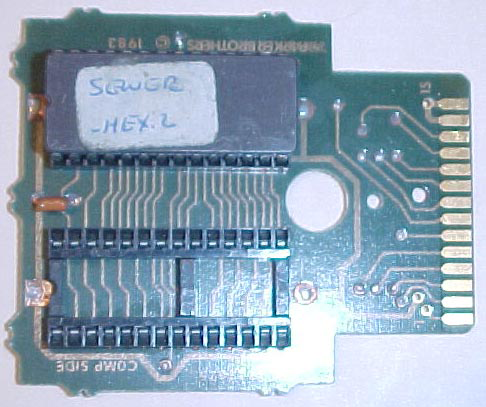
A copy of the binary ROM can be downloaded HERE.
| GAME | SYSTEM | COMPANY | STATUS |
| Star Wars - Return of the Jedi: Ewok Adventure | Atari VCS/2600 | Parker Brothers | not released |
| Frogger II: Threeedeep! | Atari 400/800, Atari 5200 | Parker Brothers | released |